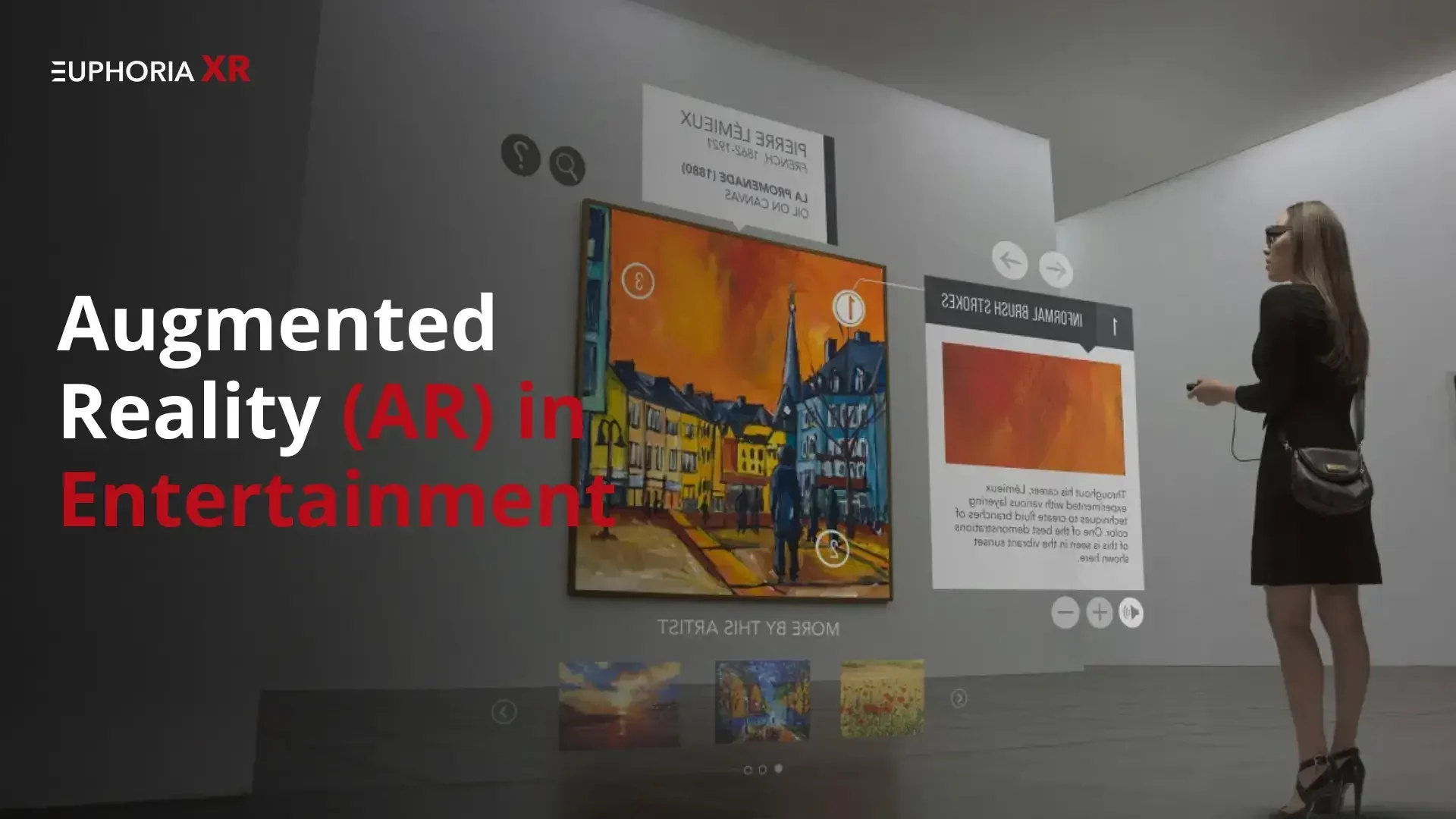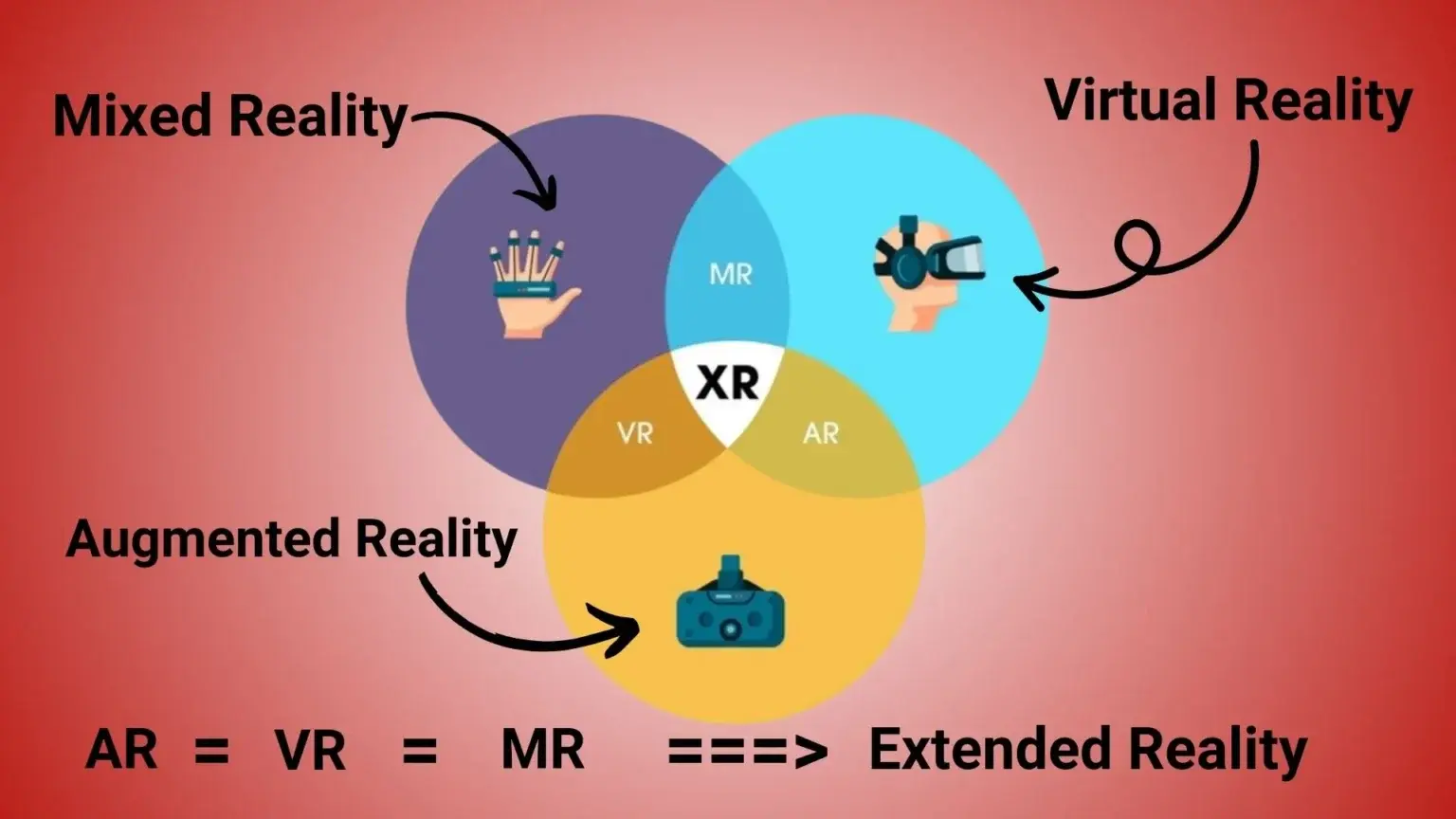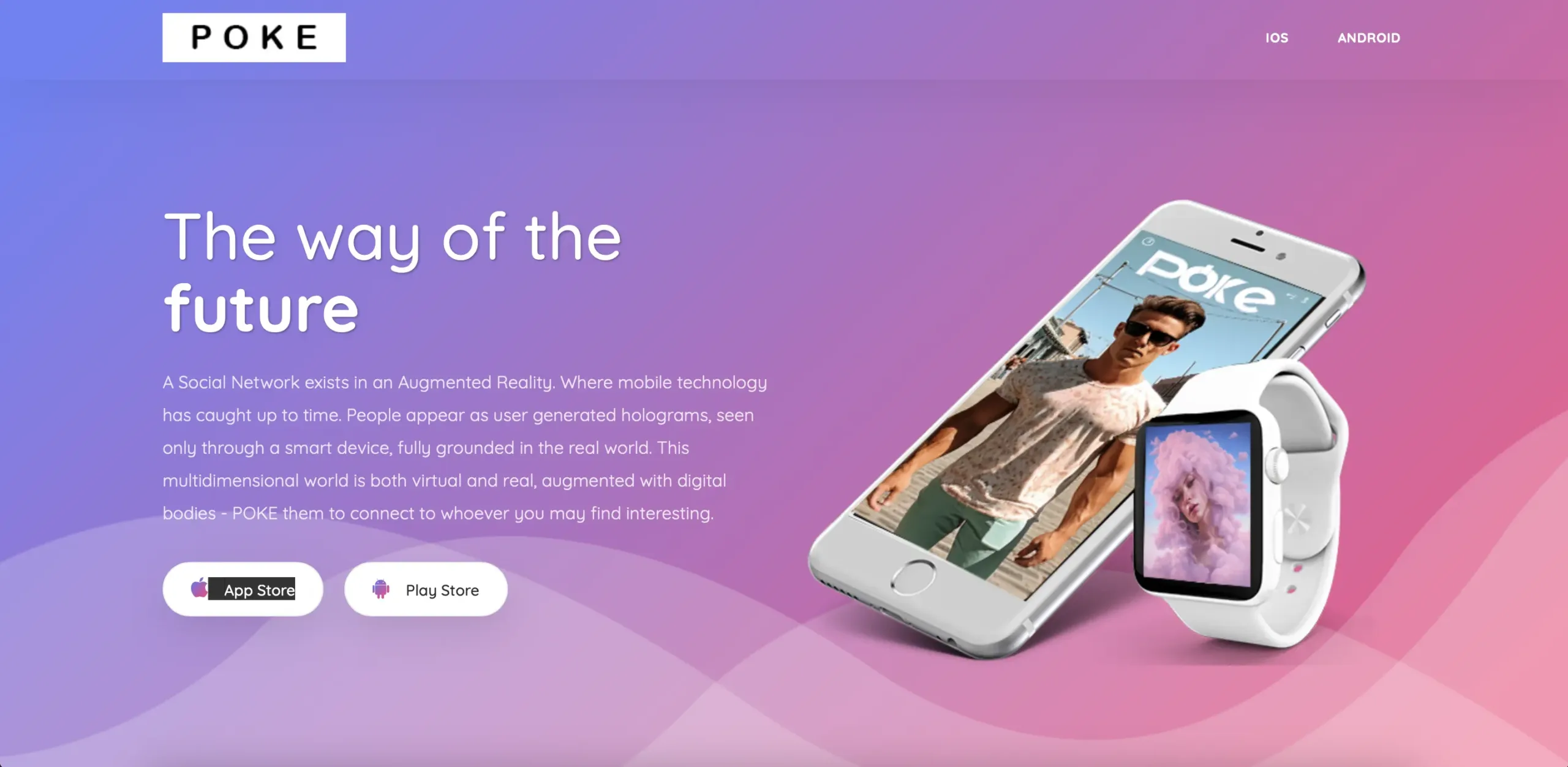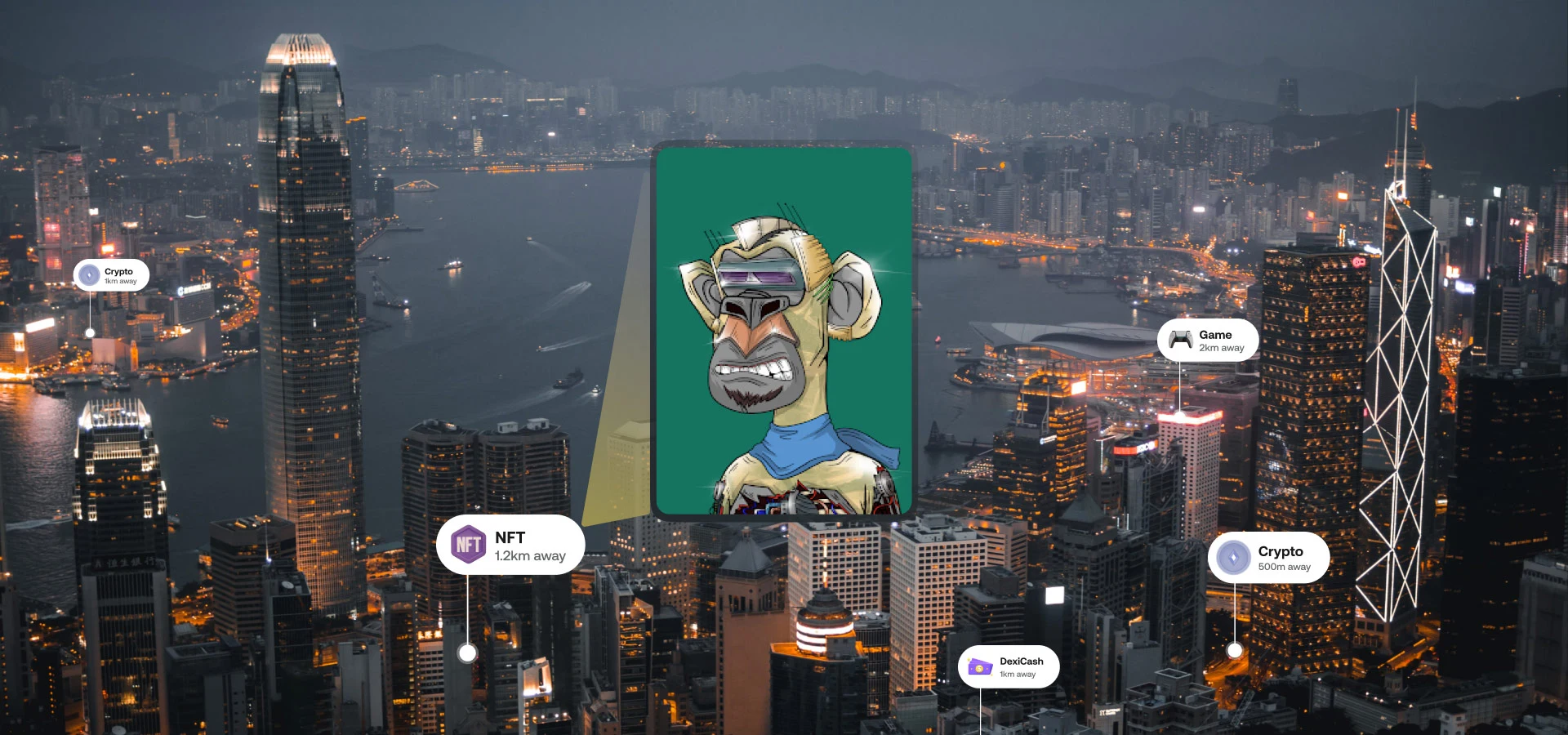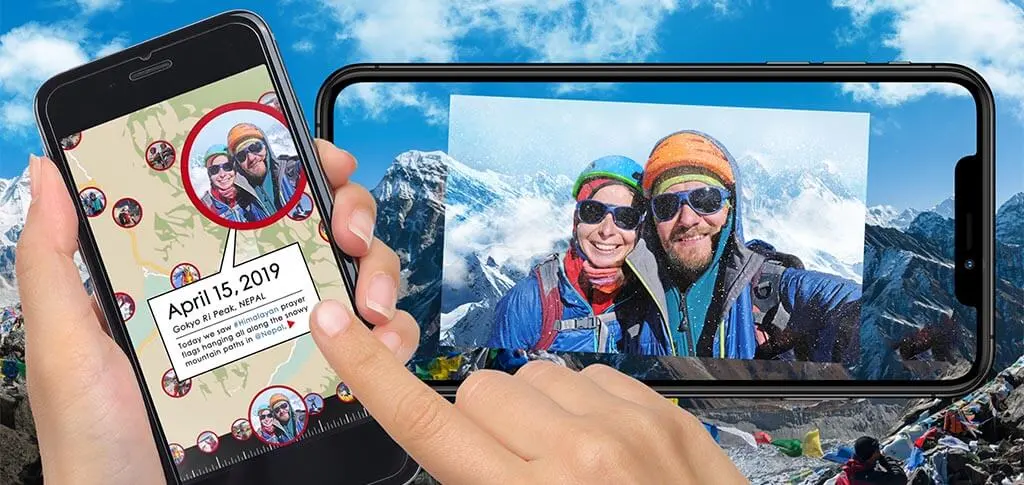Ever just feel that the regular entertainment is not as good as it used to be?
You have watched all the storylines of the plot, have gone through thousands of videos, and still want something new, something that will draw you. This is the issue that the majority of the audience experience in the current situation: it is overstimulation, as opposed to actual connection.
However, what would happen should you be able to walk into the story rather than merely observe it?
That is precisely what augmented reality entertainment is achieving, making screens the stage and audiences partakers. It is not some kind of trend but the next stage of playing, performing, and experiencing art.
What is Augmented Reality (AR) in Entertainment?
Augmented Reality Entertainment merges the physical with computer-generated images, sounds, and interactive experiences to produce immersive experiences.
AR allows you to experience a movie around you, in contrast to watching it on the screen. It works with your phone, tablet, or headset to project virtual experiences into the real world it slapping some digital effects onto otherwise mundane environments to make playgrounds of the ordinary.
Then, when you view animated characters on a staged live screen, apply a digital filter that re-creates your face, and play a game that mixes with your living room, that is augmented reality entertainment at work. It is the ability to combine fantasy and reality to bring tales to life.
Difference between AR, VR, and MR
These three are often mixed up, but the easy way out is as follows:
AR(Augmented Reality): The virtual world of digital objects is added to the real one. Your environment is perceivable to you also, but with images, audio, or information.
Virtual Reality (VR): Substitutes your real environment with an all-digital computerized environment. A simulated environment is presented to you by putting on a headset.
Mixed Reality (MR): This overlays the two worlds together, the real and the virtual object interacting in real time.
Therefore, AR does not take you out of the reality experience when using it in entertainment; it adds creativity over the underlying reality, so that concerts and games, and shows become more interactive.
History and Evolution of AR in Entertainment
The concept of AR has been evolving for many decades, but it has been able to really gain traction with smartphones and improved sensors. AR emerged in small-scale (mobile filters, AR Exhibits & Museums, and performances on the stage) in the early 2010s.
Next came AR Gaming, visuals of live events, and filters in social media, which included digital effects as part of daily entertainment.
Nowadays, augmented reality entertainment has reached much further than novelty. It is being used today by artists, film producers, sports leagues, and brands as a means of interactively, real-world storytelling to get in touch with their audience.
Impact on Media and Storytelling
AR has transformed the mode of storytelling and consumption. It helps eliminate the barrier between viewers and producers and engages audiences rather than taking them in as spectators.
Digital effects can be employed in a concert where they respond to the movements of the audience. Ancient history can be revived in a museum with the aid of 3D reconstructions. A live show may have added features of interactiveness, which you can explore on your phone.
It is a new era of entertainment where an individual does not just watch stories, but they experience them.
Are you willing to make your vision come true? Discuss your upcoming project with how AR will help take it to the next level.
The Rise of Augmented Reality (AR) in the Entertainment Industry
AR entertainment is no longer a curiosity, but is becoming part of culture – meaning, no longer a small creative experiment, but something large-scale, and capable of uniting people, brands, and technology.
It is in this transformation that EuphoriaXR has been leading the pack with its industry-defining AR experiences that are storytelling, interactive, and technology mixed. The following are four of the most interesting projects that demonstrate the extent to which AR in entertainment has been adopted.
POKE: Augmented Reality Adventure Experience
The POKE project of EuphoriaXR reinvents interactive entertainment by exploring the real world. This AR adventure merges between player interaction and narration, and allows people to explore a digital world that is superimposed on the real setting.
Gamers can gather, socialize, and explore concealed virtual factors, an ideal instance of the manner in which augmented reality entertainment will turn real-world spaces into play rectifications
DEXIHunter: Web3-Driven Augmented Reality Experience
The DEXIHunter experience is built upon a blend of blockchain innovation and AR in the entertainment sector, which introduces a real-time gamified Web3 universe giving users the opportunity to hunt, trade, and collect digital assets.
This project demonstrates the collaboration between AR and decentralized technology to create novel types of interactive experiences; a combination of entertainment, gaming, and crypto economics into an ecosystem.
BLACK: Unbreakable AR History Exhibit
EuphoriaXR made cultural narratives happen with the help of AR with BLACK. The project includes an interactive exhibition to celebrate Black history and resilience, and brings to a unity of teaching and emotional experience with the use of AR.
Tourists can interact with historical accounts, artistic content, and thought-provoking images that can be overlaid on their personal physical space, thus demonstrating that AR in entertainment can also teach, inspire, and celebrate history.
REPLAY AR: Augmented Reality Social App
ReplayAR is an innovative project that turns memories into an interactive experience. It anchors photos and moments to real-life places to enable users be able to revisit personal or collective memories with the use of AR.
This is a social innovation that emphasises the emotional dimension of augmented reality entertainment, the ability to connect people in time, place, and digital storytelling.
The portfolio of EuphoriaXR demonstrates how AR is no longer a mere effect but an activity so meaningful. The future of entertainment is connected with merging the worlds of imagination and reality, as all projects, such as gamified adventures and cultural exhibits, demonstrate.
How is Augmented Reality Used in Entertainment?
Key Applications
AR entertainment is transforming the interaction with the content. It is no longer a case of watching it but now about being involved. AR introduces digital images, movement graphics, and words in the real world, making any place part of the narrative.
The most common uses include:
Practical experiences with fused performance and online animation.
AR games that allow players to move around in real spaces.
Interactive displays in reaction to user movement.
Seamless film, show, and concert extensions available as Smartphone applications.
Within the gaming context, all the way up to the theater industry, AR enables developers to create experiences that develop in real time with interaction from the audience so that entertainment becomes more intimate and memorable.
Core Technologies
AR is based on three technologies:
Computer Vision: Assists equipment in identifying and mapping actual environments.
Motion Tracking: It is the ability to track human movements such that digital effects become perfect in reality.
Rendering Engines: Use the engine to create images that appear to be natural on real-life lighting and point of view.
These technologies are integrated to form seamless augmented reality entertainment that occurs behind the scenes. Take 5G networks, AI algorithms, and spatial sound, and you would have the real-life, responsive entertainment that will respond immediately to users.
AR Hardware and Software
AR entertainment operates on either standard or specialized devices.
Hardware: Smartphones, tablets, AR glasses (such as HoloLens or Magic Leap), and wearable headsets.
Software: AR apps and development platforms like ARKit and ARCore, as well as Unity, that enable their creators to create interactive 3D tools.
The majority of individuals perceive AR in entertainment via phones, which is why social media, the gaming industry, and event services have embraced it at such a fast rate. With the decreasing cost of the headset, entire body AR experiences will expand even more.
Get connected with a skilled Augmented Reality Development Company that transforms imaginative concepts into engaging, interactive experiences.
Top Applications and Use Cases of AR in Entertainment
AR in entertainment is more than an extraordinary notion in the future; it is reshaping the way individuals entertain, watch, and interact. AR makes the imagination gain physicality, starting with gaming and even in museums. This is how it is being used in other fields.
Gaming and eSports
The core of the augmented reality entertainment is gaming. The AR games remove the boundary between the virtual and the real, as they put the digital items in the environment of a player.
Players do not sit and do nothing; they move about, discover, and touch their physical world. This brings a more social, active, and emotional gameplay.
AR is implemented in eSports to display data, effects, and live statistics on a competition, allowing the audience to perceive the game in new dynamic ways. What it produces is a closer connection between the player and the audience- and a game that never becomes two-dimensional.
Movies and Television
AR is transforming the manner of cinematic narration. It would be like explaining to someone how they can point their phone at a movie poster and get the characters on it to move, or unlock the hidden secrets with an application, and still stream.
AR is also applied in marketing, but filmmakers also utilize AR in production nowadays – creating digital sets and effects, and seeing them on the screen even before production starts.
To viewers, it creates a discovery layer. The films are brought to life and the worlds become living, adding to the screen and increasing the engagement and replay value.
Live Events and Concerts
AR is turning the concerts into a multi-sensory experience. As the fans uplift their phones, onscreen images can erupt on the stage, miraculous light patterns, flying lyrics, or hologram performers in live action.
It is not subject to special effects but to a common immersion. Each individual in the crowd can have a tailored and interactive edition of the show.
AR enables artists to engage with the audience in a whole new manner, one way or another, allowing each of the performances to have a unique “wow factor” which the audience recollects even after the performance ceases.
Theme Parks and Attractions
Theme parks capitalize on imagination, but AR brings it to a new level. AR visitors can wear Arab reality glasses or utilize mobile applications to unveil concealed tales, characters, or missions all over the park.
Dragons may appear flying next to you, using a roller coaster. There is a treasure hunt that can drive you through attractions.
These activities make each of such visits special. Rather than merely observing, guests engage, and they combine adventure, stories, and technology in real time.
Museums and Exhibitions
AR is entertainment of culture and history. Exhibits that were previously behind glass cases in museums are now exhibits that move, talk, or change whenever looked through a device.
Not only with the help of an ancient object you can observe how that object used to be on the time of its creation, but you are also able to learn about a 3D model of a dinosaur skeleton live before your eyes.
To curators, it is a means to make education fun and immersive. To the visitors, it is one of the reasons to enjoy the stay longer and to immerse more closely with the stories behind each work.
Suggested Read: https://euphoriaxr.com/ar-in-museum/
Theatre and Performances
Stages have always been a place of illusion, and AR is interactive in terms of those illusions. Directors project live actors onto it using digital sets, creatures, or environments.
More visuals will be overlaid on the stage with the use of AR glasses or applications so that the audience can view additional details and make every performance a masterpiece of mixed reality.
This makes traditional theatre juxtaposed to something that is hybrid: half live, half digital, full alive.
Sports Broadcasting
AR is transforming the manner in which sports are viewed by fans. The broadcasters can now superimpose live statistics, paths, and player commentaries on the field.
You can know just how quickly a ball was sent, the direction it took, or even compare athletes in real time.
In the case of in-stadium fans, AR can be used to add some interactive content via apps, replays, or trivia, which will be displayed on your screen as you follow the match. The outcome: intelligent, more entertaining, and customized viewing.
Marketing and Advertising
The marketing of entertainment is an AR playground. Brands have replaced single-directional advertisements, providing people with experiences to play with.
A film advert may make you scan a product and unlock a secret scene. A music label may create an AR filter that will allow fans to play with their favorite artist.
This is where storytelling intersects with engagement and entertainment with brand connection. AR marketing transforms the viewers into participants, as opposed to spectators.
Social Media and Influencer Content
AR Filters have transformed the content creation process of people. Their purpose is to create distinctive effects, create a virtual set, and communicate with followers in an innovative manner brought about by the influencers. That began as fun filters, but has turned into a new language of online expression, with all stories, posts, and reels becoming a mini-production.
It has a viral effect as this type of augmented reality entertainment is social in nature. Millions of people use AR in their daily lives, and they probably are already contributing to its development.
Education and Edutainment
AR makes the process of learning an adventure. It is being used in educational platforms to visualize scientific content, such as human anatomy to space exploration, by telling a story and making use of 3D models. Students may take a stroll through history, view into the workings of machines, or observe physics at work too closely.
This blend of learning and entertainment, sometimes referred to as edutainment, can be seen to demonstrate the strength of AR when imagination collides with learning. It not only educates, it motivates.
AR entertainment is crossing all the lines, from art to advertisement, and from classrooms to concerts.
All these applications have one commonality, and that is the future of entertainment is audience involvement. In AR, it does not want to tell a story, but rather experience it.
Benefits of Augmented Reality in Entertainment – Infographics
The AR in entertainment is not just about visual effects, but communication, engagement, and individualisation. It welcomes the audience into the story world rather than making them stay on the other side of the screen. This is how it is changing the experience of both the creators and the fans.
Enhanced Engagement
AR makes entertainment interactive. People do not only watch, they play, move, and explore, which makes their experiences easily memorable.
New Storytelling Formats
In AR, creators have an opportunity to develop stories that happen in space and time. It is a fresh dimension of creativity as the audience is put within the story.
Revenue Opportunities
Virtual merchandise through AR event tickets can help creators and brands not only create new revenue but also create value for the fans.
Cross-platform Reach
AR will work on phones, tablets, and headsets, so creators can get an instant global connection without the need to spend a lot on the equipment.
Real-time insights
AR entertainment offers real-time feedback on healthier audiences, which assists teams in alleviating and customizing subsequent experiences.
Looking to scale your team? Hire an AR developer to create and present interactive and interactive augmented reality entertainment.
Augmented Reality in Marketing and Brand Experiences
AR has transformed brand interaction with consumers. By virtually reinforcing the visuals and real-time engagement, the AR marketing experiences of EuphoriaXR convert engagements to emotions and storytelling to impact.
AR Mirror: Interactive Brand Engagement Experience
EuphoriaXR’s AR Mirror transforms regular screens into brand activations.
Customers are able to pose before a digital mirror and virtually try on products, accessories, or filters in real-time. It is a retail entertainment experience whose brands are finding a potent tool to capture and get more audience engagement, a real augmented reality marketing.
Interactive AR Business Cards: Visual Feeder Collaboration
Together with Visual Feeder, EuphoriaXR created interactive AR business cards by incorporating design and storytelling. Seeing them on a smartphone, the cards display 3D effects, branded materials, and motion graphics, turning a simple interaction of contacts into an accessible digital experience, which is an ideal scenario of augmented reality entertainment, and this is how a brand is used in professional branding.
AR Face Effects and Filters: Social-First Brand Experiences
AR filters and effects of EuphoriaXR enable the brands to produce interactive, engaging content to be shared via their social networks. Regardless of product launches, influencer campaigns, or live events, these AR filters add personality and emotion to online branding. These filters allow businesses to engage audiences at a human level by interacting with them through interactive
Storytelling.
Related: https://euphoriaxr.com/ar-in-marketing/
AR Storytelling and Audience Immersion
The art of storytelling is the core of entertainment, and AR provides it with new dimensions. It is a mix of creativity, technology, and empathy to produce stories that react to the viewer. Every experience is alive, personal, and emotional.
Interactive narratives
AR makes the narrative experience a movie. The audience can move, select, and influence the occurrences, which makes every trip different.
Personalization
AR changes according to the environment, preferences, and manner of the user, making every experience unique and vivid.
Emotional engagement
Connection works when the stories take place in your own realm. AR contributes to stronger feelings between designers and consumers.
Immersive journalism
In media and documentaries, AR assists individuals to enter into real stories, generating some sense of understanding through the experience.
Evolution of AR in the Entertainment and Media Sector
AR began with an artistic trial: filters, mini games, and stage design. Now it is an international product of creators, brands, and viewers. Entertainment has ceased to be a field of curiosity; it has been completely adopted, and no line between the real and the digital world exists.
Early adoption of mainstream
At the start, AR was considered futuristic. Now, it has become a daily form of entertainment, on stage, social media, video games, and commercials. It changed the shift with the availability of AR to all people, without prioritizing technology lovers with smartphones and 5G.
Role of major tech companies
The major corporations such as Apple, Meta, Google, and Snap have boosted the development of AR. They created studio and developer tools, such as platforms and cameras, that enable creators to experiment and develop without involving their complicated system. This has made AR not a niche trend anymore but a creative standard.
Industry transformation
AR has transformed the production, selling, and consumption of stories. Now, studios arrange immersive campaigns in addition to releases, artists use AR images on live performances, and viewers demand interactivity as a component of entertainment. The outcome resembles an outcome that is more fascinating and multi-dimensional media.
Related: https://euphoriaxr.com/augmented-reality-in-sports/
Challenges and Limitations of AR in Entertainment
Although entertainment through augmented reality is rapidly expanding, there are actual constraints that are external to the framework, making its rapid implementation difficult. In the industry, between the cost and content creation, the industry is yet to strike the right balance between innovation and accessibility.
Hardware and cost
Good quality AR tools and techniques of production may be costly. Smartphones also have simple AR; however, the luxurious experiences require more advanced headsets, sensors, and budgets.
Connectivity
AR requires high-speed internet and powerful devices. Connection issues, either lag or poor connections, may ruin the immersion, particularly when it is in the form of a live or large-scale event.
Content creation
AR experiences require time, expertise, and technology to design. It demands groups that know how to tell stories and how to do 3D design, and not all brands or studios can afford to do it.
User fatigue
The excessive visual stimulation may result in overburdening the users. A good AR design must be in balance with reality, but not crammed in.
Privacy and ethics
AR gathers information about cameras, microphones, and the tracking of locations. Companies should be safe with user information, and they should utilize it well, as this will help them gain trust and repeat interest.
Innovative AR Entertainment Services by EuphoriaXR
EuphoriaXR is a pioneer in innovation in the field of AR, and it assists entertainment brands in designing memorable moments. Combining innovation and new technologies, the company arranges interactive concerts and virtual museum exhibits, down to branded AR activities.
Their services transform a non-theatrical space into a playground where art, narrative, and audience intersect in the real world. EuphoriaXR unites strategy, design, and technical know-how to transform augmented reality in entertainment and make it affordable, interactive, and future-oriented.
Future of AR Entertainment: Trends and Possibilities
The future of AR is very bright, interactive, and more reachable than ever. Due to the developments in the field of technology, entertainment will no longer be displayed on screens but will encompass. The future of AR creates how the field of AR will influence the media and the future of media, creativity, and engagement.
XR convergence
The AR, VR, and MR are coming together and forming a unified ecosystem known as Extended Reality (XR). Users will no longer need to switch between devices; in the future, they will enjoy the full spectrum of immersion over one platform.
AI-driven personalization
Artificial intelligence will enable AR to be more intelligent and flexible. It will personalize content, graphics, and experience based on personal tastes, developing entertainment that will be made to order by all viewers.
Multi-user AR
AR will not be an individual experience anymore. The same augmented environment will be practiced among friends, fans, or whole audiences; they will be getting together to watch concerts, games, or shows in real-time, regardless of the distance.
AR in streaming and media
AR overlays are starting to be tested on streaming activities to enhance live events, sports, and movies. In one user experience, you can envision sitting at the computer and viewing a movie and looking at some interactivity on your screen, or sitting in front of the screen and viewing live signals as a game is being played on your screen.
Immersive advertising
There will be advertising as a part of the story. The brands will place their message within the experience, very subtle, playful, and interactive, instead of interrupting the entertainment with AR.
Start your augmented reality development journey right now to see where your next AR breakthrough begins.
Conclusion
AR in entertainment is not a trend; it is the next stage of human invention. Music and sports, as well as art and education, AR relates the audience to stories on a deeper, more emotional level. With the blurred lines between physical and digital, one thing is evident: the future of entertainment will be experienced and not merely observed.
Frequently Asked Questions (FAQs)
What is augmented reality entertainment?
It is the application of AR technology to fuse virtual images, audio, or sounds with reality experiences such as concerts, games, and movies.
How is AR used in the entertainment industry?
AR is applied in games, live events, marketing, movies, sports events, and social media to make experiences interactive and immersive.
What are the benefits of AR in media and entertainment?
It increases the interactions, creates the freedom to tell new stories, establishes new revenue streams, and delivers meaningful insights in real-time.
What challenges exist in AR entertainment?
The key barriers to large-scale adoption are costs, connectivity, complexity of content creation, and privacy.
What is the future of AR in entertainment and marketing?
Anticipate customized experiences with the help of AI, collective experiences on AR, and immersive brand storytelling that is part of entertainment.

